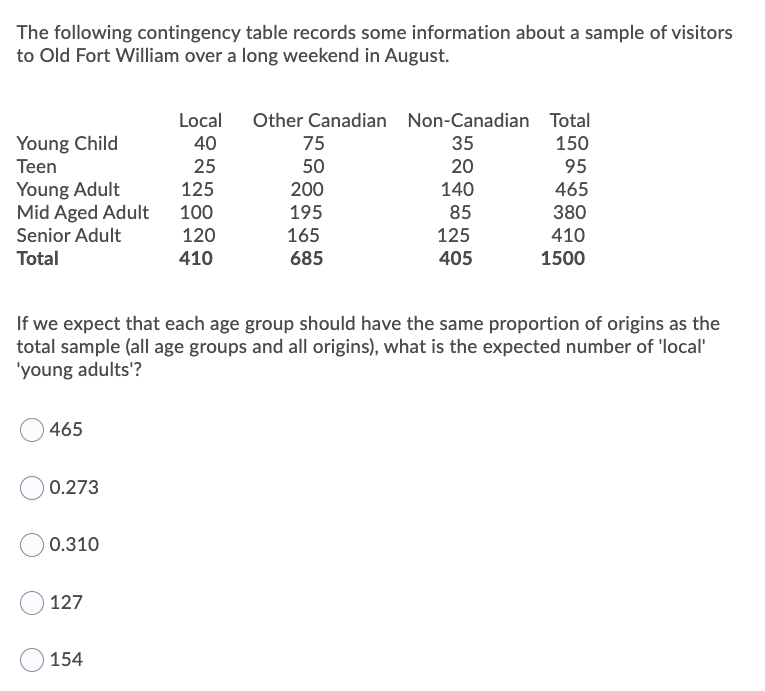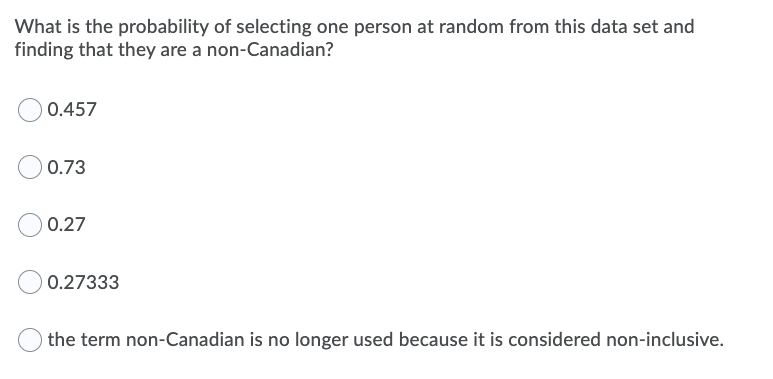The following contingency table records some information about a sample of visitors to Old Fort William over a long weekend in August. Local Other Canadian Non-Canadian Total Young Child Teen 40 75 50 35 20 150 25 95 Young Adult Mid Aged Adult Senior Adult 125 200 140 465 100 195 85 380 120 165 125 410 Total 410 685 405 1500 If we expect that each age group should have the same proportion of origins as the total sample (all age groups and all origins), what is the expected number of 'local 'young adults'? 465 0.273 0.310 127 154
The following contingency table records some information about a sample of visitors to Old Fort William over a long weekend in August. Local Other Canadian Non-Canadian Total Young Child Teen 40 75 50 35 20 150 25 95 Young Adult Mid Aged Adult Senior Adult 125 200 140 465 100 195 85 380 120 165 125 410 Total 410 685 405 1500 If we expect that each age group should have the same proportion of origins as the total sample (all age groups and all origins), what is the expected number of 'local 'young adults'? 465 0.273 0.310 127 154
Holt Mcdougal Larson Pre-algebra: Student Edition 2012
1st Edition
ISBN:9780547587776
Author:HOLT MCDOUGAL
Publisher:HOLT MCDOUGAL
Chapter11: Data Analysis And Probability
Section11.4: Collecting Data
Problem 6E
Related questions
Question

Transcribed Image Text:The following contingency table records some information about a sample of visitors
to Old Fort William over a long weekend in August.
Local
Other Canadian Non-Canadian
Total
Young Child
Teen
40
75
35
150
25
50
20
95
Young Adult
Mid Aged Adult
Senior Adult
125
200
140
465
100
195
85
380
165
685
120
125
410
Total
410
405
1500
If we expect that each age group should have the same proportion of origins as the
total sample (all age groups and all origins), what is the expected number of 'local'
'young adults'?
465
0.273
0.310
127
154

Transcribed Image Text:What is the probability of selecting one person at random from this data set and
finding that they are a non-Canadian?
0.457
0.73
0.27
O 0.27333
the term non-Canadian is no longer used because it is considered non-inclusive.
Expert Solution
This question has been solved!
Explore an expertly crafted, step-by-step solution for a thorough understanding of key concepts.
Step by step
Solved in 3 steps with 2 images

Recommended textbooks for you

Holt Mcdougal Larson Pre-algebra: Student Edition…
Algebra
ISBN:
9780547587776
Author:
HOLT MCDOUGAL
Publisher:
HOLT MCDOUGAL

College Algebra (MindTap Course List)
Algebra
ISBN:
9781305652231
Author:
R. David Gustafson, Jeff Hughes
Publisher:
Cengage Learning


Holt Mcdougal Larson Pre-algebra: Student Edition…
Algebra
ISBN:
9780547587776
Author:
HOLT MCDOUGAL
Publisher:
HOLT MCDOUGAL

College Algebra (MindTap Course List)
Algebra
ISBN:
9781305652231
Author:
R. David Gustafson, Jeff Hughes
Publisher:
Cengage Learning
